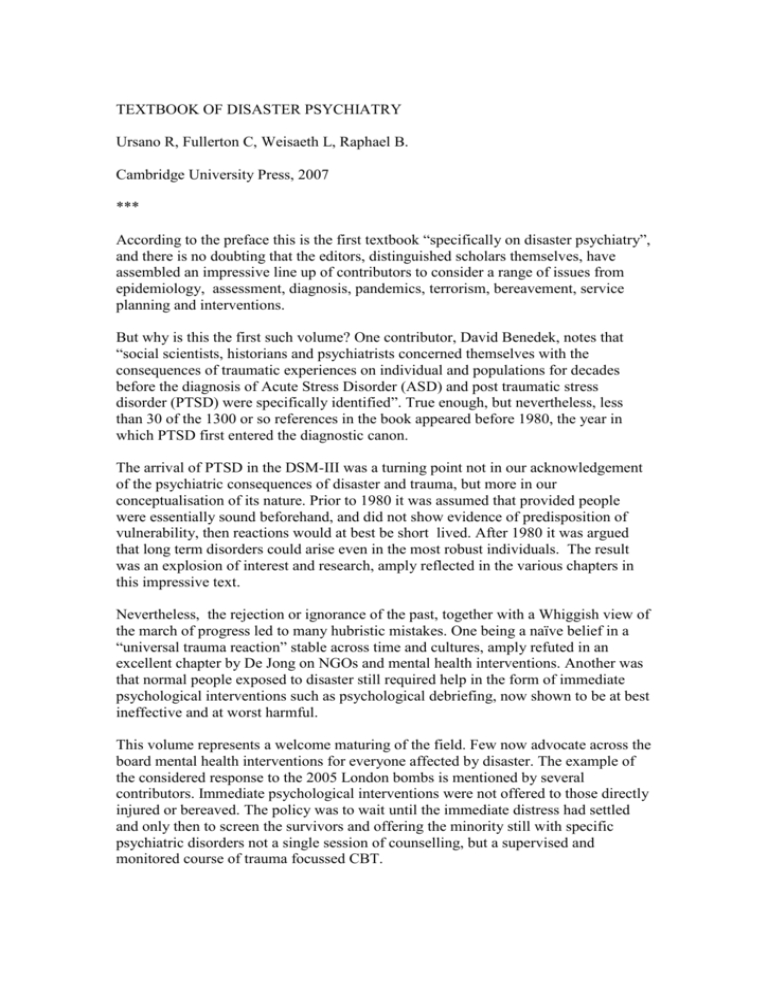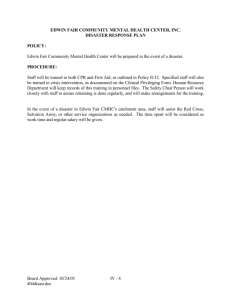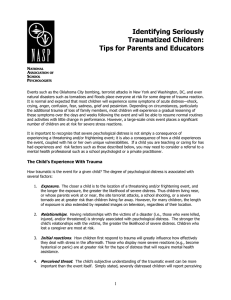TEXTBOOK OF DISASTER PSYCHIATRY
advertisement

TEXTBOOK OF DISASTER PSYCHIATRY Ursano R, Fullerton C, Weisaeth L, Raphael B. Cambridge University Press, 2007 *** According to the preface this is the first textbook “specifically on disaster psychiatry”, and there is no doubting that the editors, distinguished scholars themselves, have assembled an impressive line up of contributors to consider a range of issues from epidemiology, assessment, diagnosis, pandemics, terrorism, bereavement, service planning and interventions. But why is this the first such volume? One contributor, David Benedek, notes that “social scientists, historians and psychiatrists concerned themselves with the consequences of traumatic experiences on individual and populations for decades before the diagnosis of Acute Stress Disorder (ASD) and post traumatic stress disorder (PTSD) were specifically identified”. True enough, but nevertheless, less than 30 of the 1300 or so references in the book appeared before 1980, the year in which PTSD first entered the diagnostic canon. The arrival of PTSD in the DSM-III was a turning point not in our acknowledgement of the psychiatric consequences of disaster and trauma, but more in our conceptualisation of its nature. Prior to 1980 it was assumed that provided people were essentially sound beforehand, and did not show evidence of predisposition of vulnerability, then reactions would at best be short lived. After 1980 it was argued that long term disorders could arise even in the most robust individuals. The result was an explosion of interest and research, amply reflected in the various chapters in this impressive text. Nevertheless, the rejection or ignorance of the past, together with a Whiggish view of the march of progress led to many hubristic mistakes. One being a naïve belief in a “universal trauma reaction” stable across time and cultures, amply refuted in an excellent chapter by De Jong on NGOs and mental health interventions. Another was that normal people exposed to disaster still required help in the form of immediate psychological interventions such as psychological debriefing, now shown to be at best ineffective and at worst harmful. This volume represents a welcome maturing of the field. Few now advocate across the board mental health interventions for everyone affected by disaster. The example of the considered response to the 2005 London bombs is mentioned by several contributors. Immediate psychological interventions were not offered to those directly injured or bereaved. The policy was to wait until the immediate distress had settled and only then to screen the survivors and offering the minority still with specific psychiatric disorders not a single session of counselling, but a supervised and monitored course of trauma focussed CBT. And for the rest of us, the vast majority of Londoners who had experienced fear, disruption and outrage, but were not direct victims, no across the board interventions were offered. Instead what was encouraged was “doing what comes naturally” – which means mobilising one’s own social support networks by talking to friends, relatives, colleagues, or perhaps general practitioners or vicars if need be, but not mental health professionals. Being able to communicate directly with family and friends on the day was vital for reassurance and resilience – in our study those who could not make such contact were not only more distressed in the days afterwards, but continued to more distressed six months later. The chapters in this volume now reflect this new thinking. Patricia Watson emphasises the psychological importance in the immediate response period of “helping survivors meet their basic needs (eg safety, shelter, food rest) as well as providing soothing human contact and information” . There is no need in those first few days to go around asking “how do you feel?”, since the answer is likely to be “dreadful – how do you think I am going to feel?”. Other contributors describe how professionals may be required to ensure that the flood of well meaning but untrained volunteers wanting to do just that is checked, and instead resources focussed on providing longer term, evidence based treatments to the minority, to be delivered by appropriate trained professionals once the dust has either literally or metaphorically settled and the media circus moved on. The volume also contains well argued contributions on mechanisms, including psychology and neurobiology, and even some, albeit not enough, sociology. Those who have to plan disaster services may however skip those sections, and instead focus on more practical issues, such as body handling, and on planning and services, where they will find much common sense advice, even if it is not always new. For example, it is acknowledged by historians, even those of the revisionist tendency, that civilian morale did not collapse in either Britain or Germany during the Second World War, despite both populations being subject to a deliberate policy of strategic bombing intended to destroy resilience and create panic. Neither goal was achieved the much anticipated epidemic of mental disorders never materialised. And what they learned about disaster psychiatry (not that they called it that) remains true today. “The morale of the bombed largely depends on the care they get in the first 36 hours….rest centres, facilities for children, information, health care and the provision of food” (1). The past is not always a foreign country, and it still has a lot to teach us. Simon Wessely Director, King’s Centre for Military Health Research Institute of Psychiatry, King’s College London (1) PRO, HO 199/442 “Report on Liverpool and Manchester 10th Jan 1941” cited in Jones, E., Woolven, R., Durodie, B. & Wessely, S. Civilian morale during the second world war: responses to air raids re-examined. Social History of Medicine 2004: 17, 463-479.











